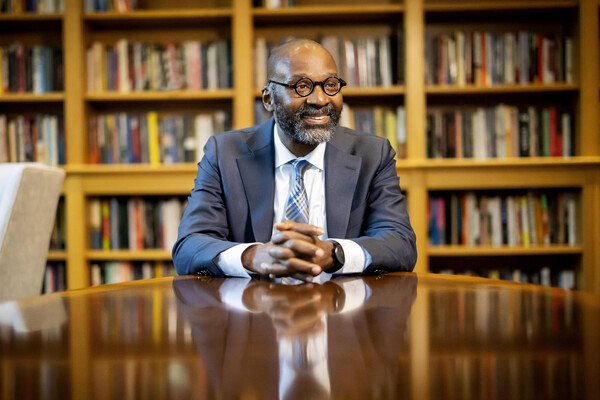
Griffin Pitt, right, works with two other student researchers to test the conductivity, total dissolved solids, salinity, and temperature of water below a sand dam in Kenya.
(Image: Courtesy of Griffin Pitt)
 Photo credit:Candace diCarlo
Photo credit:Candace diCarlo The average American is bombarded daily by countless images and pictures in magazines and newspapers, on TV and the Web, and on billboards, buses and buildings.
But not long ago, such images hardly existed at all, says Michael Leja, a professor in Penn’s Department of Art History.
“You think now about how much time we spend looking at pictures in a given day,” Leja says. “Almost everything we read is illustrated and so many of our relations with people are mediated by pictures, either of ourselves or something else. We talk about TV programs or YouTube videos, but it wasn’t that long ago that pictures were quite rare and counted only infrequently. And they had a kind of magic power attached to them because of that rarity.”
Leja, a scholar of visual arts from the 19th and 20th centuries ... primarily in the United States, is currently working on a book that will explore changes in pictorial forms and social relations associated with the early days of mass-market images. To support his efforts, Leja was recently named a recipient of three prized fellowships—one from the American Council of Learned Societies, one from the in-residence program at the Clark Art Institute in Williamstown, Massachusetts and, maybe most impressively, a Guggenheim Fellowship.
Leja, who is at the end of his third year at Penn, is also the author of the 2004 book, “Looking Askance: Skepticism and American Art from Eakins to Duchamp,” which one critic called “an indispensable and lively study of what we might call the modern anxiety of seeing.” His research is rounded out in the classroom, where he teaches an introduction to Art History on the rise of modern visual media, and an undergraduate seminar on art in Philadelphia in the 19th century.
“It’s a great subject,” Leja says. “Philadelphia was a fantastic center for art in the 19th century and there’s so many great resources here, both in terms of museum holdings and archival collections. The class meets at a different place every week, sometimes two places in a single meeting, and the students really have to get in the archives and get their hands dirty and they love it.”
Q. How is your research going for your book project? What exactly are you looking at?
A. This book I’m working on is about not the very beginnings, but as close to the beginning as we can get, of the flood of pictures in the 19th century. ... I’m looking at the moment in the 19th century, primarily focusing on the United States as a case study, and looking at the 1840s and 50s and 60s, when there’s really a critical development in this proliferation of pictures. It’s partly a result of the new media being invented and new technologies—steam-powered printing presses—but at that moment, the production of pictures gets industrialized, mechanized and production operates on a mass scale in a way that hadn’t been possible before. So I’m just trying to see what happens at that moment in terms of artistic traditions and how they change as a result of these new developments.
Q. From what you’ve been able to tell so far, did those traditions become simplified?
A. Well, I think they change [but] it’s not always simplification. It’s not really lowering some kind of intellectual sophistication in pictures as much as it is trying to make them appeal to a broad audience. The people who are first trying to reach a mass audience have to actually produce that mass audience, because it’s not preexisting. There’s a bunch of factions—people with different backgrounds and languages and so forth. So picture-makers have to find a way to introduce broadly interesting subjects and styles into their work. They draw on all kinds of artistic traditions from the past. The people who are producing the illustrative magazines at this moment are using medieval manuscripts, for example, very heavily and they’re putting pictures together in new ways. There’s multiple pictures on a single page of a publication in a magazine and they’re thinking creatively about how to relate those pictures to one another and how to group them and create a voice. They actually invent the early collage process that became really crucial for fine art traditions in the 20th century. ... It’s actually doing creative things, putting those traditions together and producing new ideas that will influence fine art traditions later.
Q. How does photography fit in?
A. Photography comes in, but you can’t make a massive number of prints from a single image until the 1850s, even though photography comes in 1839. Daguerreotypes are unique images and calotypes–salt prints—are small-edition, handcraft kind of production of images. So it’s not until the glass plate negative in the ‘50s that people like Mathew Brady and others start mass-producing images and mass-distributing them. And they’re usually portraits of celebrities, politicians, famous actors or actresses.
Q. Those are the same kind of people whose images are photographed and distributed to a mass audience today, right?
A. Yes, but I don’t think ‘celebrity’ is really there yet—people who are famous for being famous. They have usually done something to deserve fame. Although that doesn’t last for long—P.T. Barnum gets into the act. He gets celebrity going.
I neglected to say that I’m looking at two things in this project. One is the way in which artistic traditions change and the other is the way in which social relations change as a result of being mediated by pictures. People start, with photography, to get large numbers of portraits of themselves to circulate to their friends and collect in photo albums.
This becomes an extremely popular pastime and exchanging of photographs is a lot like “friending” somebody on Facebook and a way of producing a social network. But it’s not just young people who are doing it—it’s everyone.
Q. Is that something that only the rich and middle class could afford, or did working class people participate as well?
A. Well, it goes increasingly down the social scale in affordability but it’s surprising. You can find daguerreotypes, even before carte de visite portrait photographs, which is what I was just talking about. Before that, we get people having daguerreotypes made who were clearly not affluent, not even necessarily middle class, people living on the frontier, living in a log cabin. We have daguerreotypes of families like that.
Q. How did you become interested in this topic?
A. It came from my last book project, which was on the growth of skepticism as a predisposition of people viewing art in the 19th century. That project brought me to look at a lot of popular culture and mass culture images and how they revealed the influence of a kind of skeptical viewing attitude on the part of audiences, and responses to that on the part of people who made these images, either trying to persuade skeptics to be more vehement about their truth claims or playing along, making a game of the skepticism and inviting the viewers to try and test him or herself against the skills of the artist. There’s a lot of mass cultural interest in this. A lot of production is engaged with these issues.
That just brought up larger questions about what’s happening as mass visual culture really gets going. There are a lot of theories about this that are out there and we take the theories for granted now as truth, but there haven’t been many efforts to test them empirically against data from one place or multiple places. So that’s also a motivation of this study.
Q. What are some of the theories out there about mass visual culture?
A. Some of the most influential ones come from the Frankfurt School and the idea of the aura of the work of art being erased by the commonplace character of these mass-produced images. There are all kinds of theories about what happens, how power gets exerted socially through pictures, how elites use images for reform projects—which they do. This is absolutely true that they tried to use artistic images to acculturate immigrants, socialize immigrants, elevate the working class. Those words ‘acculturate’ and ‘elevate’ really mean, ‘indoctrinate in aesthetics and a set of beliefs,’ but it’s not quite that simple.
There are interesting ways in which elites are changed by mass tastes. There are interesting cases in which elite audiences [are not] able to resist what they consider debased or vulgar entertainments and we can see evidence of their patronizing these kinds of amusements and forms of art and their tastes shifting as a result of this. This is something I want to work on further.
Q. What are some of those ‘debased’ entertainments?
A. Vaudeville or cheap theater. Some chromolithographs that are made—say Currier and Ives or other companies. The Prang company is very well known. Prang makes high-class color prints that tend to conform to the tastes of the elites, whereas companies like Currier and Ives try to appeal to the mass market. They make extremely sentimentalized images, and their narrative, in a flat-footed way, is a little bit too simple. They celebrate things that working class men’s groups would like, the kinds of things they’d like to hang in their interiors. Whenever there’s a market, someone tries to satisfy it. Some succeed and some don’t, but some have a surprising amount of social influence.
Q. Is this the first time in this country that we see a mass market?
A. Yes. I think a lot of historical and cultural historians talk about this movement as the emergence of a mass audience and mass culture and it’s only really possible to have something distributed on a mass scale when you have rail networks and industrialized paper production and steam-powered printing presses. So you’re actually seeing the same image go across the country through all of these new developments. Those are really early 19th century breakthroughs.
Q. How did all of this effect politics and the election process?
A. Part of my study deals with the artist William Sidney Mount, who was a specialist in scenes of daily life in the 1830s and 40s, and he had complicated relationships with the Whig party at this moment, but he’s trying to reach a mass audience with his pictures and he’s trying to produce images that have political meanings but they’re ambiguous enough to appeal to people on multiple sides of any issue.
So, that’s one of the things that I’ve been looking at and been amazed by how effectively he manages to engage people who think they understand exactly what he’s saying, but what their understanding is, is completely different from what someone else is understanding of the same image. That’s a skill that I think he’s helping to pioneer that’s going to become crucial for anyone appealing to a mass audience politically, as well as artistically, and culturally later on.
Q. Do you mean he uses images like, say, the flag in political advertisements or is it subtler than that?
A. It’s kind of esoteric. It’s coded symbolisms from the moment. Cider-making, for example, was part of the political contest. He makes a painting of these people making apple cider and it engages directly with what one of the parties is having cider-making stand for in their political platform. So it seems to be supportive of these views but at the same time, it’s susceptible to reading it as a critique of that party’s positions. It’s not so simple as the flag or any kind of recognizable emblems. It’s really insider reading.
It would have been like taking one of the key themes of the current Presidential campaign—either hope and change or qualifications—and making a picture that was about that, but was unclear about its attitude towards that entity.
Q. Have you made any exciting discoveries in your research that you’d like to share?
A. Two examples have been exciting for me lately. I’ve been working on the artist Winslow Homer, who’s fairly well-known as a painter, but less well-known as a magazine illustrator in the 1860s. He went to the front during the Civil War and sent back drawings that were reproduced in Harper’s Weekly and other pictorial publications. I’ve been looking at the way he puts images together in composite groupings and the subtlety— really, the sophistication—of his arrangements and the ways that they allow him to reinforce the theme of an image or strengthen its power through combination and arrangement and intersection of images.
I’ve just been collecting images by him that combine lots of simple images into one larger totality and I’m surprised by how many of these there are, how little attention has been paid to them up until now and how provocative they are for thinking about what happens in the coming generations in both mass art and fine art.
Q. And the other discovery?
A. I’m dying to get to work on a Philadelphia topic, related to this project, which is a publisher of color lithography who was based in Philadelphia named Duval. He was a French immigrant who had artistic training in France but was interested in developing improved technology for reproducing and making mass numbers of prints, using multiple stones, to get great color, bright color, clear color, also realistic color. He’s constantly showing his work at Franklin Institute exhibitions, which are kind of trade shows, through the 19th century, where people who do any kind of work with new image technologies exhibit their work—photography and printmaking, especially. I’m interested in looking at the progress of his work, technologically, through what he shows and what he advertises at the Franklin Institute exhibitions. Also, he works with an artist—this is not very well-known—named Christian Schussele.This is someone who is a teacher at the Pennsylvania Academy of the Fine Arts school, and who also has artistic training from France and is an immigrant after the revolution of 1848. [He] works very closely with Duval in devising new color lithographs that are meant to appeal to a mass audience.
And Schussele is very inventive about thinking about the possible ways of designing subjects that will add mass appeal. That’s what I’m hoping to get to work on this summer. There’s lots of pieces of Philadelphia history that I’d love to get to at some point.
Originally published May 8, 2008

Griffin Pitt, right, works with two other student researchers to test the conductivity, total dissolved solids, salinity, and temperature of water below a sand dam in Kenya.
(Image: Courtesy of Griffin Pitt)

Image: Andriy Onufriyenko via Getty Images

nocred

Provost John L. Jackson Jr.
nocred